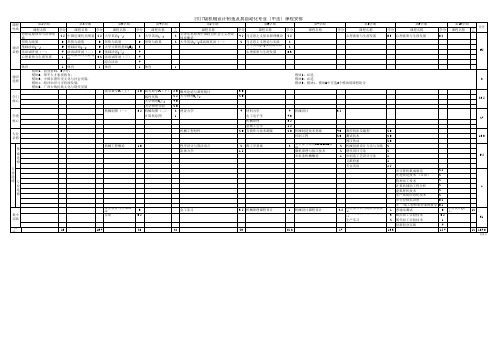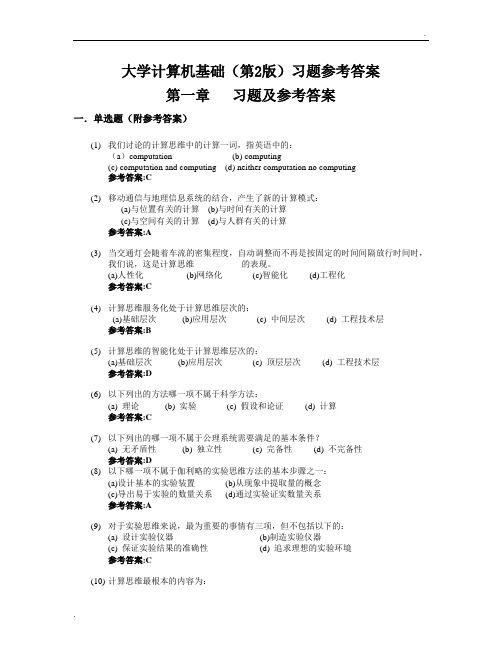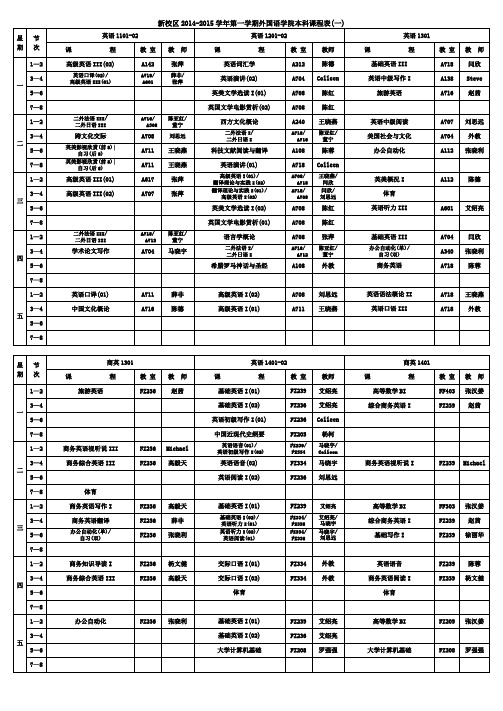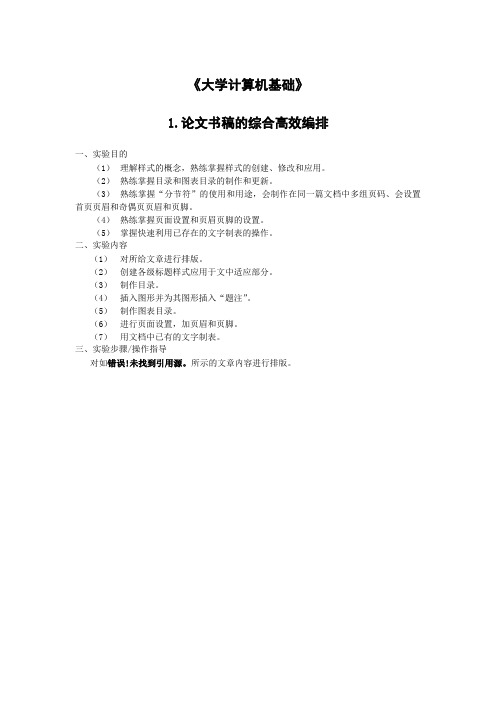大学计算机基础英语教学 (2)
应用型本科院校计算机基础教学改革研究

应用型本科院校计算机基础教学改革研究作者:关洁来源:《广西教育·C版》2021年第03期【摘要】本文以广西大學行健文理学院为例,分析应用型本科院校在计算机基础教学中面临的问题,明确对现有计算机基础课程进行改革的必要性,提出大学计算机基础课程的改革和实践方案:实现分类教学,侧重实践教学,引入NCRE,开展线上线下混合教学等。
【关键词】计算机基础教学分类教学实践教学 NCRE 线上线下混合教学【中图分类号】G 【文献标识码】A【文章编号】0450-9889(2021)11-0154-032015年11月,教育部高等学校大学计算机课程教学指导委员会正式发布《大学计算机基础课程教学基本要求》,指出大学计算机基础教学的总体目标为“大学生通过学习应能够理解计算学科的基本知识和方法,掌握基本的计算机应用能力,同时具备一定的计算思维能力和信息素养”。
计算机基础课程作为高校学生的一门公共必修课,是高校学生知识结构体系的重要组成部分。
在新工科背景下,如何培养学生的信息素养,切实提高学生的计算机应用水平,是应用型本科院校的计算机基础课程面临的新挑战。
一、计算机基础教学存在问题分析(一)教学内容陈旧信息技术发展日新月异,计算机技术已经成为现代人社会生活必备的技能。
作为新时代的本科院校,培养大学生能在各自的专业领域熟练应用计算机技术是十分必要的。
目前国内一些本科院校开设的公共计算机课程“大学计算机基础”沿用传统的教学模式,存在课程更新速度慢、教学内容“一刀切”等问题。
所有专业的“大学计算机课程”全部采用统一的教学大纲和教材授课,部分理工科专业的学生觉得内容太简单,部分文科专业的学生觉得内容太难,难以达到各专业人才的培养目标。
(二)教学方式单一大学生是一个思想活跃和求新求异的群体,对所学内容和教育方式都有特别的需求。
在传统的大学课堂教学中,通常以教师教为主体,学生被动接受知识,“满堂灌”“填鸭式”的教学方式往往导致学生学习积极性不高,课堂气氛沉闷。
广西大学教学计划专业推荐选课表-机自(中法)

专 业 选 修专
业 选 修
机械工程概论
集中 实践
合 计:
安全教育与军事训 练 劳动
16
16.7
学分
第4学期 课程名称
2 大学英语(二)
0 形势与政策 3 4 4 4 1 体育
2017级机械设计制造及其自动化专业(中法)课程安排
第5学期
学 分 2
课程名称 毛泽东思想和中国特色社会主义理论 体系概论
5.0 高等数学A(下) 5.0 概率论论与数理统计
线性代数理I(上) 4.0
大学物理实验 2.0
3.5 机械制图(二) 2 理论力学
计算机绘图
1
机械工程材料
1.0
程序设计与算法语言
流体力学
3.0 2.0
4 材料力学 电工电子学 机械原理 金属工艺学
2.0 互换性与技术测量
课程
第1学期
性质
课程名称
思想道德修养与法律基
础
形势与政策
学分
第2学期 课程名称 学分
第3学期 课程名称
2.5 中国近现代史纲要 2.5 大学英语(一)
0 形势与政策
0 形势与政策
通识 基础法语(一) 必修 法语试听说(一)
心理素质与生涯发展
6 基础法语(二)
6 大学计算机基础(B)
4 法语试听说(二) 6 基础法语(三)
2
特种加工技术
2
计算机辅助工程分析
2
虚拟样机技术
2
生产系统信息化技术
2
※行业精英讲座
0.5
※ 一线工程师典型案例教学 0.5
1 普通话测试 3 数控加工实验技术
0
毕业设计(论 文)
英语专业人才培养方案

2 34 试 34
2 34 试 34
2 34 试 34
2 30 试 30
2 34 试 34
2 34 试 34
2 34 试 34
1
0查 0
1
0查 0
2 34 试 34
2 34 试 34
2 34 查 34
2 34 查 34
2 34 查 34
1 17 查 17
4.5 75 试 75
5 85 试 85
5 85 试 85
英语专业人才培养方案
一、培养目标 本专业培养能适应地方现代化建设需要,德、智、体、美等方面全面协调发展,具有扎 实的英语语言基础知识和基本技能,较宽广的文化知识和较高的人文修养,较强的适应性和 创新精神,能胜任中学英语教学工作或在外事、经贸、旅游等领域从事英语翻译、商务管理 等涉外商务活动的应用型高级专门人才。 二、培养要求 1、具有坚定正确的政治方向,热爱社会主义祖国,拥护中国共产党的领导,掌握邓小 平理论和“三个代表”重要思想的基本原理,树立科学的世界观,正确的人生观和价值观; 遵纪守法,敬业爱岗,团结合作,具有良好的思想品德和职业道德; 2、具有扎实的英语语言基础知识,熟练地掌握听、说、读、写、译的基本技能; 3、掌握英语语言文学、英语国家文化及相关人文和科技方面的基础知识; 4、具有第二外国语的基本应用能力,掌握计算机应用技能,达到学校规定的要求; 5、获得科学研究的初步训练,掌握基本的科研方法,具有独立获取知识,提出问题、 分析问题,解决问题的能力和较强的创新意识; 6、“教师教育方向”学生具有现代教育观念,了解英语教育科学发展与中小学教育改革 实践,先进的教育教学方法和现代化的教育手段,具有较强的英语教育教学能力、教育管理 能力、教育科研能力,能适应现代教育教学改革发展的需要; 7、“商务英语方向”学生掌握现代商务基础理论,熟悉国际商务活动领域的一般性知识, 具有较强的英语商务交际、商务写作、商务翻译能力,商务管理能力,以及协调各种业务关 系的能力; 8、掌握体育、卫生保健和心理调适的基础知识,养成文明的生活习惯,达到国家规定 的《大学生体质健康标准》,具有健康的体魄、良好的心理素质。 三、主干学科与主要课程 主干学科:英语语言文学 主要课程:英语听力、英语口语、英语阅读、英语写作、英语语法、英汉笔译、汉英笔
英语专业课程体系图

英语专业课程ห้องสมุดไป่ตู้系图
课程体系
Types
课程
Courses
通识教育课程
大学计算机基础Basic of Computers for College,思想道德修养及法律基础The Culture on Thought and Morality as well as Foundations of Law,体育(一)Physical Education (1),大学生心理健康Mental Health for College Students,军事理论Military Doctrine,军训Military Training,中国近现代史纲要Outline of China's Modern History for Nearly,体育(二)Physical Education (2),当代世界经济与政治Contemporary World Economy and Politics,人文科学类选修课Optional Courses for Students of Humanism and Science,Excel and Powerpoint,马克思主义基本原理The Basic Principles of Marxism,体育(三)Physical Education (3),体育(四)Physical Education (4),毛泽东思想、邓小平理论和“三个代表”重要思想概论General Introduction to Mao Zedong Thoughts,Deng Xiaoping Theory and the Three-representative's Theorie,毕业教育graduation education
商务英语方向
计算机大学论文2500字_计算机大学毕业论文范文模板

计算机大学论文2500字_计算机大学毕业论文范文模板计算机大学论文2500字(一):对基于计算机的大学英语教学模式的重新审视论文摘要:为了适应社会的发展,满足社会的需求,高校正在以学生为中心进行改革,比如增加了合作项的学习、社会实践类的学习、提出了学习共同体的思维,其中最重要的一项是信息技术与课程的整合。
基于最重要的这一项,早在2007年7月国家教育部就颁布了相关文件——《大学英语课程教学要求》,其中一个要求就是“基于计算机的大学英语教学模式”。
该要求旨在强调要打破传统教学模式,提倡学生自主学习,教师个性化教学。
虽然在相关文件和各个高校的努力下,学生学习英语的效率有所提升,英语教学的改革也初见成效,但当前的教学模式还是不能让人满足。
笔者结合自己的工作经验,对基于计算机的大学英语教学模式进行了分析,希望对高校教育的改革有所帮助。
关键词:计算机;大学英语;教学模式;重新审视虽然计算机在大学应用教学中被广泛的应用,但是基于计算机的大学英语教学模式并没有得到很好的展现。
原因在于:在大学课堂之上,很多教师都会使用计算机,但是基本是使用计算机放映外文电影或者是播放教学幻灯片。
这种教学方式虽然说改变了传统的板书教学,但是在科学技术日新月异的今天,还是和如今大学英语教学改革背道而驰。
如今高校改革是为了提倡教师个性化教学,为了促进学生自主学习,鼓励培养学生的主动性。
使用计算机制作幻灯片在技术角度来说实现起来比较简单,而且有利于教师对所要讲解知识的梳理。
但从教育方面来说,使用幻灯片对于学生学习英语的帮助是微乎其微。
对于教师而言,教书育人是责任,但使用最佳的方法,最大化的提高学生的外语能力则是一种艺术。
因此,我们必须要考虑如何正确的使用计算机进行教学,如何能够发展我们个性化的“基于计算机的大学英语教学模式”。
1基于计算机的大学英语教学模式实施的原因这种模式的诞生,最初是因为外界的压力。
随着时代的发展,全球化进程的不断推进,校园之外的公司、企业、政府机要部门迫切的需要大学生能够熟练的使用英语,可以运用英语进行必要的交流和工作,但结果并不尽如人意。
翻转课堂在“大学计算机基础”课程教学中的应用

第18卷第6期南阳师范学院学报Vol.18No 62019年11月JournalofNanyangNormalUniversityNov.2019收稿日期:2019-06-20基金项目:校级课堂教学改革项目(2016 ̄KTJX ̄11)作者简介:王㊀达(1979 ㊀)ꎬ黑龙江哈尔滨人ꎬ硕士ꎬ主要从事软件开发㊁数据库应用方面的研究.翻转课堂在 大学计算机基础 课程教学中的应用王㊀达ꎬ张㊀坤(南阳师范学院计算机与信息技术学院ꎬ河南南阳473061)㊀㊀摘㊀要:针对同一门课程«大学计算机基础»ꎬ对英语专业学生讲解过程中采用传统教学和翻转课堂教学相结合的 混合式 教学方法ꎬ而对中文专业学生仅采用传统教学方法ꎬ经过2个专业的学生一个学期的学习对比发现ꎬ采用 混合式 教学方法的英语专业学生课堂上学生交流互动的频率高ꎬ学生学习新知识的积极性㊁自主思考和主动探索的意识特别强ꎬ学生动手实践能力也相对提高.关键词:大学计算机基础ꎻ翻转课堂ꎻWordꎻExcelꎻPowerPoint中图分类号:G642㊀㊀㊀文献标志码:A㊀㊀㊀文章编号:1671-6132(2019)06-0076-03㊀㊀ 大学计算机基础 课程是大学生迈进大学校门后第一学期开设的必修课程ꎬ是一门实践性很强的学科ꎬ主要培养学生实践动手能力.课程的教学目标不仅要求学生掌握基础理论知识ꎬ还要求能够熟练操作Word㊁Excel㊁PowerPoint等Office办公软件ꎬ从而提高学生在信息技术应用方面的能力ꎬ奠定学习其他计算机语言类课程的基础.相比传统教学法ꎬ在 大学计算机基础 课程中应用翻转课堂模式ꎬ能更好地达到教学目标要求.1㊀翻转课堂的特点2007年ꎬ美国科罗拉多州伍德兰中学的JonBergmann和AaronSam两位教师第一次提出了 翻转课堂 这种教学模式[1]ꎬ模式中要求学生课下自学教师所发的视频ꎬ课堂时间主要用来解决学生学习过程中遇到的问题ꎬ从而使教师成为学生学习的组织者㊁引导者ꎬ而不再是说教者.这样ꎬ不仅加强了学生与学生之间的互动交流ꎬ共同合作ꎬ并且实现了教师与学生之间的角色互换ꎬ进而促进学生分析问题㊁解决问题的能力[2].学生有更多的课堂时间来反复讨论学习内容以及学习过程中遇到的问题ꎬ扩展和加深学生对知识的认识与理解ꎬ进而提高学习效率.2㊀翻转课堂的应用翻转课堂[3](FlippedClassroom)的特点是学生课前观看相关知识的视频文件ꎬ课堂上通过小组讨论或教师的指导来完成规定好的作业ꎬ从而实现知识内化ꎬ完成相关知识的传递.讲授 大学计算机基础 课程过程中ꎬ以大班授课的方式进行ꎬ每个大班包括3个小班ꎬ通过对2017级英语专业1㊁2㊁3班和汉语言文学专业1㊁2㊁3班的具体教学实践中应用翻转课堂教学模式和传统教学模式.2.1㊀课前准备首先ꎬ针对英语专业的学生以小班为单位组建3个QQ学习群ꎬ方便学生与教师之间的交流和学生接收相关的视频文件等.其次ꎬ课前针对 大学计算机基础 课程的培养目标㊁重点㊁难点知识ꎬ制作好相关的教学视频ꎬ视频要求形式多样ꎬ保证视频中的知识点讲解相比教师课堂讲授更生动㊁形象和清晰.采用软件屏幕录像专家和CamtasiaStudio两个工具结合录制视频文件ꎬ视频录制时长为5~8minꎬ以.MP4格式保存ꎬ学生可以通过手机或电脑等终端观看ꎬ不受时间㊁地点的约束[4].同时ꎬ在学生观看视频后及时对学生掌握知识的情况进行分析ꎬ安排一定数量和难度的练习题ꎬ使学生既巩固新知又使其学习具有一定的挑战性ꎬ最大可能地激发学生学习的积极性.在视频学习过程中ꎬ要求学生保质保量地完成新知的学习和作业ꎬ㊀第6期王㊀达ꎬ等:翻转课堂在 大学计算机基础 课程教学中的应用还要如实地记录自己所遇到的问题ꎬ并通过交流群及时反馈给教师ꎬ教师要及时搜集整理学生学习过程中存在的问题ꎬ为下一步的课堂教学活动做准备[5].2.2㊀课堂应用学生学习完视频后ꎬ教师及时收集整理学生在自主学习过程中的各种疑惑ꎬ并根据这些问题设计课堂相关活动ꎬ有目的地引导学生参与相关的实践活动.以 Word长文档排版 为例ꎬ具体流程如图1所示.图1㊀课程流程图(1)对特定问题分解细化.教师疑问解答环节ꎬ针对学生课前视频学习的反馈ꎬ共性问题投屏广播解答ꎬ而特定问题需一对一分析答疑.另外ꎬ在知识扩展环节ꎬ以 邮件合并 为例ꎬ如应用规则时由于错误操作会导致软件自动关闭等问题ꎬ采用翻转课堂教学模式ꎬ提出问题学生同组投屏演示ꎬ其他学生参与ꎬ教师协助ꎬ让学生成为学习过程中的主体ꎬ使学生在轻松愉快的环境下学习和探讨.(2)学生小组讨论环节ꎬ将学生分为多个小组ꎬ设定讨论知识点ꎬ引导学生集体讨论学习过程中遇到的各种问题并找到解决办法ꎬ从而进一步深入挖掘相关知识.在此过程中ꎬ教师从教学的主导者转变为组织者㊁管理者及参与者ꎬ并加入他们当中ꎬ和学生一起讨论.如果在讨论过程中ꎬ遇到学生解决不了的瓶颈问题ꎬ教师就是一个引导者ꎬ并能及时给予学生正确的引导ꎬ以提高他们参与讨论学习的积极性[6].(3)上机实践环节ꎬ教师的角色转变为组织者ꎬ将小组讨论的零散知识点ꎬ教师加以组织ꎬ设计综合实践测验文档ꎬ从而完成知识的内化ꎻ知识点梳理环节ꎬ学生反馈本节课的重点难点ꎬ教师总结ꎬ指出不足并强化指导.当学生对学习过程感兴趣之后ꎬ就想成为学习的主人ꎬ教师也就变成了学生学习的引导者.翻转课堂这种新的教学模式ꎬ不仅可以加强学生与学生之间的协作㊁互助ꎬ也可以加强教师与学生之间的互动和交流ꎬ从而提高学生分析和解决问题的意识和能力[7].2.3㊀课后复习课后复习环节ꎬ单独整理学生在课前和课中遇到的疑难问题ꎬ形成文档分发给学生ꎬ供学生梳理知识点ꎬ尽可能多地拓展知识点的深度和广度ꎬ让学生在反思㊁总结过程中再上一个新台阶.对于实践操作知识ꎬ要时刻关注学生的动手能力ꎬ设计操作练习作业ꎬ每次把作业截图配上素材及要求打包发给学生ꎬ让学生在课下进行自主上机练习ꎬ做到自我测评ꎬ反馈测评结果ꎬ掌握自身情况ꎬ针对易错步骤反复练习操作ꎬ强化动手实践能力[8].2.4㊀期末验收考试形式为无纸化上机考试.本次期末考试在机房进行ꎬ每人一台机器ꎬ采用开放式考试系统(OCTS)软件进行测试ꎬ考试时间系统自动计时ꎬ全程视频监控.OCTS软件是一套适用于 大学计算机基础 课程的练习与测试系统ꎬ其特色在于考试过程管理的自动化和测试结果评判的自动化ꎬ提升了教学效果评判的准确性ꎬ降低了考试过程的烦琐程度ꎬ提高了教学和实验质量.学生考试时系统随机组卷ꎬ保证每位学生抽取不同的试题ꎬ能够检验出学生对 大学计算机基础 课程的操作能力的掌握情况ꎬ从而为他们参加全国计算机等级考试做好充分准备.用同一套软件进行测试ꎬ通过6个班级成绩分布情况分析ꎬ结果采用翻转课堂教学方法的班级优秀的人数所占比例高达50%以上ꎬ个别班级甚至达到60%以上ꎬ良好和中等占比30%以上ꎬ及格最高仅仅8%ꎻ而没有采用翻转课堂教学方法的班级优秀率最高仅为13%ꎬ大部分集中在良好和中等ꎬ及格比例占比22%以上ꎬ还出现了不及格的情况.3㊀结束语综上所述ꎬ翻转课堂与师范院校 大学计算机基础 课程教学的结合ꎬ是对传统教学模式的提升和互补ꎬ体现课堂的主体是学生ꎬ激发学生学习的主观性ꎬ通过翻转课堂实践教学ꎬ让学生参与整个教学环节ꎬ强化了师生间的联系ꎬ提高学生的动手实践能力ꎬ培养学生自主学习和探究新知的能力ꎬ从而提高教学质量.7787南阳师范学院学报㊀第18卷㊀参㊀考㊀文㊀献[1]㊀王薇ꎬ李芳.翻转课堂的共性问题㊁内涵及教师个性化施教探讨[J].黑龙江畜牧兽医ꎬ2018(12):240-242. [2]㊀郝琦蕾ꎬ王丽.国内翻转课堂教学模式研究述评[J].中国现代教育装备ꎬ2018(9):97-102.[3]㊀钮永莉ꎬ魏光杏ꎬ李华.基于微课的翻转课堂教学设计与实践[J].吉林工程技术师范学院学报ꎬ2018ꎬ34(5):76-77. [4]㊀王跃华ꎬ孙雁霞ꎬ向达兵ꎬ等. 翻转课堂 教学模式在普通生物学教学中的应用初探[J].教育教学论坛ꎬ2018(26):185-186.[5]㊀张海山ꎬ梁文凯ꎬ何芦霖ꎬ等.翻转课堂的教学结构设计初探[J].无线互联科技ꎬ2018(12):77-78.[6]㊀李国金.大学英语教学中翻转课堂教学模式探析[J].高教学刊ꎬ2018(12):111-113.[7]㊀陈超.翻转课堂在高校计算机教学中的应用[J].电子世界ꎬ2018(11):83-84.[8]㊀韦银蓝.翻转课堂在中职网页设计与制作课程中的应用探究[J].科学咨询ꎬ2018(6):106.ApplicationofflippedclassroomintheteachingofCollegeComputerFundamentalsWANGDaꎬZHANGKun(SchoolofComputerandInformationTechnologyꎬNanyangNormalUniversityꎬNanyang473061ꎬChina)Abstract:ForthesamecourseCollegeComputerFundamentalsꎬthe mixed teachingmethodcombiningtradi ̄tionalteachingandflippedclassroomteachingisadoptedinclassforstudentsmajoringinEnglishꎬwhilethetra ̄ditionalteachingmethodisemployedforChinesemajorstudents.Throughthecomparisonofthetwoteachingmethodsꎬitisfoundthatthestudentsunderthe mixed teachingmethodhaveahighfrequencyofcommunica ̄tionandinteractioninclassꎬandtheyalsohaveastrongsenseofvoluntarythinkingandactiveexplorationꎬandtheirpracticalabilityhasalsobeenbetterimproved.Keywords:CollegeComputerFundamentalsꎻflippedclassroomꎻWordꎻExcelꎻPowerPoint。
英语百科第4单元第2课

英语百科第4单元第2课摘要:英语百科第4单元第2课:计算机科学一、计算机科学的定义1.1 计算机科学的起源和发展1.2 计算机科学的学科领域二、计算机科学的基础知识2.1 计算机硬件2.1.1 计算机的组成部分2.1.2 计算机的工作原理2.2 计算机软件2.2.1 操作系统2.2.2 编程语言2.2.3 算法和数据结构三、计算机科学的应用领域3.1 人工智能3.1.1 机器学习3.1.2 深度学习3.2 计算机网络3.2.1 网络协议3.2.2 网络安全3.3 数据库技术3.3.1 数据库的基本概念3.3.2 数据库管理系统3.4 计算机图形学3.4.1 计算机图形学的基本概念3.4.2 计算机图形学的应用四、计算机科学的发展趋势4.1 大数据4.1.1 大数据的概念和特点4.1.2 大数据的应用和发展4.2 云计算4.2.1 云计算的概念和特点4.2.2 云计算的应用和发展4.3 区块链4.3.1 区块链的概念和特点4.3.2 区块链的应用和发展正文:英语百科第4单元第2课:计算机科学计算机科学是一门涉及计算机的原理、应用和发展趋势的学科。
本课程将介绍计算机科学的定义、基础知识、应用领域以及发展趋势。
一、计算机科学的定义计算机科学起源于20世纪40年代的美国,主要研究计算机的原理、设计、应用和发展。
计算机科学的学科领域包括计算机硬件、计算机软件、计算机网络、数据库技术、人工智能、计算机图形学等。
二、计算机科学的基础知识计算机科学的基础知识包括计算机硬件和计算机软件。
计算机硬件是计算机的实体部分,包括处理器、内存、输入输出设备等。
计算机的工作原理是通过执行指令来完成各种任务。
计算机软件包括操作系统、编程语言、算法和数据结构等,它们共同构成了计算机系统的灵魂。
三、计算机科学的应用领域计算机科学的应用领域广泛,包括人工智能、计算机网络、数据库技术、计算机图形学等。
人工智能研究如何使计算机具有人类智能,包括机器学习和深度学习等技术。
外语系英语专业国际传播方向本科培养方案(最新)

你外语系英语专业(国际传播方向)本科培养方案一、专业中英文名称和专业代码英语专业 English 专业代码: 050201二、学科门类和授予学位类别英国语言文学,授予文学学士学位三、专业培养目标本专业培养具有扎实的英语语言基本功,较强的英语语言运用能力,掌握国际新闻传播领域的基本专业知识与技能和一定的经济专业知识,具备较强的能力和较高的素质,能够应用中英文在国际新闻传播等领域胜任经济新闻采编、编译、节目主持、英语教学等工作的高素质复合型、应用型英语人才。
毕业适用单位为国内外各类新闻媒体、各级对外宣传部门、外事部门和企业单位等。
培养要求:1.英语语音、语调正确,词法、句法、章法规范。
认知15,000左右的词汇,熟练掌握5000个左右的常用词和短语,能流利运用英语进行日常生活的交流,在口头和书面表达时能够做到通顺流畅;能熟练运用英语进行经济新闻与文化传播的口笔译、英语广播及电视节目的播音与主持工作;2.能听懂英语广播新闻报道及各种经济新闻报道,能够正确、流利地运用英语从事国际经济新闻传播领域的相关工作;3.能阅读英文报刊杂志上有关政治、经济、文化等方面的专业报道,能阅读英文原著文献;了解英语国家的经济文化,能恰当处理各种经济新闻及文化传播业务,能参与各类中外经济文化交流活动;4.掌握国际传播方面的专业知识与技能和一定的经济专业知识,能用英语进行采访、经济新闻采编,能够迅速、准确地完成英语经济新闻稿件的撰写、编译以及文化交流活动。
四、学制四年五、毕业合格标准及学分要求(一)毕业学分要求最低总学分:178学分其中:必修课111学分选修课最低学分:42学分实践环节:25学分(二)获得学士学位除满足学校规定的学位授予条件外,英语必须通过国家专业四级或大学英语六级。
六、教学计划进程表英语专业(国际传播方向)课程设置及教学进程表(2007)七、课程结构分析表表一英语(国际传播方向)专业毕业生应修学分参考表表二课程结构分析表表三英语专业(国际传播方向)课程结构表八、学生选课指导外语系英语专业学生经过前两年四个学期基础学习后,从第三年的第五学期开始,外语系提供两个方向供选择:国际商务和国际传播。
贵州大学2019级新生网上选课指南

贵州大学2019级新生网上选课指南2019级新生进校后,首先在阳明学院接受一年的通识教育,以增进对人类知识及其价值的综合理解与有效表达,从而在认知、思维、表达和应用方面达到融会贯通、厚积薄发的新高度。
根据学校要求,学生每个长学期(一学年含两个长学期一个短学期)原则上需修读20—25个学分的课程,包含学科大类必修、通识类必修和通识拓展类选修课程。
新生进校后如何选课?一、了解贵州大学教务管理系统贵州大学教务管理系统包含“通知公告、网上选课、活动报名、教学质量评价、信息维护、信息查询、毕业论文、公用信息”等8个功能模块。
如图所示:显示用户信息教务管理系统菜单栏通知公告栏,每次选课通知都可以在此查1、“网上选课”模块:包括“学生必修课选课、学生体育课选课、重修课选课、院系选修课选课、全校性选修课选课、学生补修选课”等内容。
学生必修课选课菜单项介绍,点击此菜单显示如下界面:—1——2—学生必修课选课界面涉及主要菜单有:本专业选课、跨专业选课、特殊课程选课、已选课程、查看课表。
如下图所示:本专业选课:指本专业的专业选修课程。
(本学年不涉及)点击“本专业选课”按钮,系统仅显示本专业的选修课程上课信息,学生根据实际情况选择对应的课程,是否要预订教材后按“选定”即可。
跨专业选课:可以选本学院其他专业选修课程。
(本学年不涉及)点击“跨专业选课”按钮,学生可以根据实际情况选修本学院其他专业其他年级的课程。
学生信息栏:包括学号、姓名、专业、年级、学期学生本学期课程列表这个提示很重要,没有弹出窗口,学生无法完成选课—3—特殊课程:主要包括《大学计算机基础》、《高级程序语言设计VB》、《大学英语二》、《大学日语一》。
(重要,涉及本学年)已选课程:显示本学期已选的所有课程。
也可通过菜单“信息查询”→“学生选课情况查询”方式来查询。
学生每学期选课结束后,必须认真核查自己所选的课程。
如果发现所选课程与课表不符,应及时向学院教务办(或学院教学科研科)反映。
2024河大版,计算机科学七年级下册教案英文版

2024河大版,计算机科学七年级下册教案英文版2024 River University Edition, Computer Science Grade 7 Lower Level Lesson Plan Unit 1: Introduction to Computer Science- Lesson 1: Basics of computer hardware and software- Lesson 2: Introduction to programming languages- Lesson 3: Understanding algorithms and flowchartsUnit 2: Web Development- Lesson 3: Adding interactivity with JavaScriptUnit 3: Introduction to Python Programming- Lesson 1: Basics of Python syntax- Lesson 2: Variables, data types, and operators in Python- Lesson 3: Conditional statements and loops in PythonUnit 4: Cybersecurity Basics- Lesson 1: Understanding cybersecurity threats- Lesson 2: Importance of password security- Lesson 3: Basic tips for staying safe onlineUnit 5: Introduction to Robotics- Lesson 1: Basics of robotics and its applications- Lesson 2: Building a simple robot using a robotics kit- Lesson 3: Programming the robot to perform tasksUnit 6: Introduction to Data Science- Lesson 1: Basics of data collection and analysis- Lesson 2: Introduction to data visualization- Lesson 3: Hands-on data science project using real-world dataUnit 7: Final Project- Lesson 1: Planning and designing a final project- Lesson 2: Implementing the project using the skills learned throughout the course- Lesson 3: Presenting the final project to the class and receiving feedbackThis lesson plan aims to provide students with a comprehensive introduction to various aspects of computer science, including programming, web development, cybersecurity, robotics, and data science. By the end of the course, students will have a solid foundation in computer science concepts and skills that will prepare them for further studies in the field.。
New_附件:赣南师范大学研究生招生专业目录及自命题考试 _.pdf

附件:赣南师范大学2018年研究生招生专业目录及自命题考试科目主要参考书学院代码、名称、联系人学科名称拟招生人数初试考试科目复试笔试科目同等学力考生加试科目001文学院舒六英0797-83936 43●050100中国语言文学01文艺学02语言学及应用语言学03中国古代文学04中国现当代文学05中国古典文献学30①101思想政治理论②201英语(一)③专业科目1:01方向:611文学理论02方向:612汉语基础03方向:613中国古代文学04方向:614中国现当代文学05方向:652中国古典文献学④专业科目2:811作文01、03、04方向:文学评论02方向:语言学概论05方向:古代汉语1.中国历代文学作品选2.中国现当代文学作品选*045103学科教学(语文)(兼招非全日制)不区分研究方向45①101思想政治理论②204英语(二)③333教育综合④911语文课程与教学论语文教学设计1、现代汉语2、写作*135103戏曲02戏曲编导5①101思想政治理论②204英语(二)③634艺术概论④901戏曲创作戏曲作品分析1、美学2、作文002新闻与传播学院陈老师0797-83938 76040110教育技术学01信息技术教育应用02教育媒体的理论与实践6①101思想政治理论②201英语(一)③615教育学基础综合(自命题)教育技术学导论1、大学计算机基础2、远程教育基础0501Z1媒介文化传播01新闻文化传播02广播影视文化传播03广告文化传播8①101思想政治理论②201英语(一)③616传播史论④816媒介实务媒介理论综合1、新闻学概论2、广播电视学概论*045114现代教育技术8①101思想政治理论②204英语(二)③333教育综合多媒体课件制作1、计算机网络2、数据库技术不区分研究方向④925现代教育技术*135105广播电视01广播电视编导02播音与主持艺术20①101思想政治理论②204英语(二)③634艺术概论④01方向:905广播电视实务02方向:906播音主持实务01方向:影视作品分析02方向:播音主持作品分析01方向1、广播电视概论2、视听语言02方向1、广播电视概论2、节目主持概论003政治与法律学院陈华0797-83936 460305Z1马克思主义法学01马克思主义法哲学02中央苏区法制建设03民商法学04行政法学8①101思想政治理论②201英语(一)③617马克思主义法理学④817法学综合(民法总论、刑法总论)民事诉讼法1、宪法2、政治经济学030301社会学01社会工作与社会管理02政治社会学6①101思想政治理论②201英语(一)③640社会学基础理论④840社会工作基础理论政治学原理1、管理学原理2、社会调查与研究方法*045102学科教学(思政)(兼招非全日制)不区分研究方向25①101思想政治理论②204英语(二)③333教育综合④912思想政治教育学科教学论思想政治教育学原理1、马克思主义哲学原理2、毛泽东思想和中国特色社会主义理论体系概论004马克思主义学院吴少梅0797-83978 50●030500马克思主义理论01马克思主义基本原理02马克思主义中国化研究03思想政治教育20①101思想政治理论②201英语(一)③618马克思主义基本原理④818毛泽东思想和中国特色社会主义理论体系政治学原理1、思想政治教育学原理2、社会学理论0305Z2中国共产党革命精神与红色文化资源研究01中国共产党革命精神史02红色文化资源开发利用6①101思想政治理论②201英语(一)③618马克思主义基本原理④847中共党史文化学概论1、思想政治教育学原理2、社会学理论005历史文化●030300社会学01社会学02人类学(旅游人类学、文化人类学方向)2001方向:①101思想政治理论②201英语(一)③641社会学概论④841社会学研究方法社会学理论1、中国社会学史2、发展社会学与旅游学院袁浅香0797-83936 4803民俗学02方向:①101思想政治理论②201英语(一)③642人类学理论④842人类学研究方法人类学概论(文化人类学方向)旅游学概论(旅游人类学方向)03方向:①101思想政治理论②201英语(一)③643民俗学概论④843中国文化史民俗学理论●060300世界史01地区国别史02国际关系史8①101思想政治理论②201英语(一)或203日语(全国统考)③645世界通史世界近现代史1、史学概论2、中国近现代史0602L3专门史01中央苏区与近现代中国02客家与中国文化03王阳明与地域社会10①101思想政治理论②201英语(一)③644中国通史中国近现代史1、史学概论2、中国古代史*045109学科教学(历史)(兼招非全日制)不区分研究方向13①101思想政治理论②204英语(二)③333教育综合④913历史教学论中国近现代史1、史学概论2、中国古代史006外国语学院朱永红0797-83936 50050201英语语言文学01英语文学02英语语言学03翻译10①101思想政治理论②二外(241日语或242法语)(自命题)③621综合英语(含英汉互译)④821英语写作英语语言文学综合1、英语听力2、英语水平测试*045108学科教学(英语)不区分研究方向45①101思想政治理论②204英语(二)③333教育综合④914英语课程教学论英语教学法1、英语综合能力2、英语口语007教育科学学院范春玲0797-83936 55●040100教育学01教育学原理02课程与教学论03高等教育学04学前教育学14①101思想政治理论②201英语(一)③615教育学基础综合(自命题)教育科学研究方法1、教育哲学2、中外教育史040202发展与教育心理学01发展心理学02教学心理与教师14①101思想政治理论②201英语(一)③622心理学基础综合(自命题)心理学研究方法1、认知心理学2、人格心理学教育03学校心理学04学校心理测量*045101教育管理(只招非全日制)不区分研究方向12①101思想政治理论②204英语(二)③333教育综合④923教育管理学教育科学研究方法1、学校管理学2、教育政策学*045115小学教育(兼招非全日制)不区分研究方向10①101思想政治理论②204英语(二)③333教育综合④924小学教育学教育科学研究方法1、课程与教学论2、教育心理学*045116心理健康教育(兼招非全日制)不区分研究方向12①101思想政治理论②204英语(二)③333教育综合④926发展心理学教育科学研究方法1、普通心理学2、教育心理学008数学计算机科学学院廖冬妮0797-83936 63●070100数学01基础数学02计算数学03概率论与数理统计04应用数学05数据智能分析与应用1501、02、04方向:①101思想政治理论②201英语(一)③623数学分析④823高等代数03方向:①101思想政治理论②201英语(一)③650数学基础④850概率论与数理统计05方向:①101思想政治理论②201英语(一)③651C语言程序设计④850概论论与数理统计01、02、04方向:常微分方程03方向:以下课程任选一门:应用统计学、常微分方程、C语言程序设计、SPSS软件应用05方向:线性代数01、02、04方向:1、近世代数2、实变函数03方向:1、数学分析2、高等代数05方向:1、软件工程2、数据结构*045104学科教学(数学)不区分研究方向28①101思想政治理论②204英语(二)③333教育综合④915数学教学论数学思想方法与解题1、数学分析2、高等代数*085227农业工程03农业信息技术与自动化①生物信息②农业智能数据处理10①101思想政治理论②204英语(二)③302数学(二)(全国统考)④908数据库原理C语言程序设计1、数据结构2、软件工程009物理与电●080900电子科学与技术01物理电子学10①101思想政治理论②201英语(一)③301数学(一)(全国统考)1、电磁场理论2、单片机与接口技术1、光学2、固体物理学子信息学院阮红环0797-83936 6802电路与系统03微电子学与固体电子学04电磁场与微波技术④824普通物理学或909电子技术3、信号与系统4、自动控制原理*045105学科教学(物理)不区分研究方向20①101思想政治理论②204英语(二)③333教育综合④916物理教学论电磁学1、力学2、光学*085227农业工程04智能农业检测与控制技术10①101思想政治理论②204英语(二)③302数学(二)(全国统考)④909电子技术单片机与接口技术1、信号与系统2、自动控制原理010化学化工学院潘虹0797-83936 70●070300化学01无机化学02分析化学03有机化学04物理化学32①101思想政治理论②201英语(一)③01方向:625无机化学02方向:626分析化学03方向:627有机化学04方向:625无机化学、626分析化学、627有机化学中任选1门④825物理化学综合化学1、无机化学实验2、有机化学实验081704应用化学01功能分子薄膜设计与应用02稀土金属材料开发与应用03新型药物与血吸虫防治新技术①101思想政治理论②201英语(一)③302数学(二)(全国统考)④825物理化学综合化学1、有机化学实验2、化工原理*045106学科教学(化学)(兼招非全日制)不区分研究方向15①101思想政治理论②204英语(二)③333教育综合④917化学教学论化学教学论实验1、无机化学2、有机化学011脐橙学院(生命与环境科学学院)(国家脐0703Z1化学生物学01.生物种间关系的化学基础02.脐橙化学生物技术03.脐橙资源综合利用16①101思想政治理论②201英语(一)③628生物化学(自命题)④828分子生物学或829无机及分析化学生物技术1、微生物学2、有机化学*045107学科教学(生物)12①101思想政治理论②204英语(二)生物课程教学论1、植物学13576 79798 2*135101音乐01作曲02声乐演唱03合唱指挥04钢琴演奏05器乐演奏(含琵琶、古筝、二胡、小号、小提琴)06音乐教育18①101思想政治理论②204英语二③702艺术学基础④902和声与曲式01方向:复调与作曲(笔试)02至05方向:视唱练耳(笔试)06方向:音乐教育基础理论(笔试)1、音乐基础理论2、音乐美学*135106舞蹈01舞蹈表演02舞蹈编导03舞蹈教育10①101思想政治理论②204英语二01、02、03方向:③702艺术学基础④903舞蹈艺术概论中国民间舞蹈文化1、舞蹈名作分析2、中国舞蹈发展史*135103戏曲01赣南采茶戏表演4①101思想政治理论②204英语二③702艺术学基础④904赣南采茶戏歌舞艺术戏曲表演理论1、戏曲名作分析2、中国戏曲发展史*045111学科教学(音乐)不区分研究方向8①101思想政治理论②204英语(二)③333教育综合④920音乐教育学音乐教育基础理论1、视唱练耳2、音乐美学015美术学院肖莹0797-83936 581304L1美术学01中国民间美术02中国画03油画04书法05视觉传达10①101思想政治理论②201英语(一)③634艺术概论④01方向:834中国民间美术概论02、03方向:836素描04方向:837书法史05方向:838设计表现01方向:非物质文化遗产概论02方向:中囯画命题创作03方向:油画命题创作04方向:书法创作05方向:招贴设计1、中国美术史2、外国美术史*135107美术14①101思想政治理论01方向:1、中国美术史01中国画02油画03美术教育04陶瓷艺术鉴赏研究与修复②204英语二③634艺术概论④01、02、03方向:836素描04方向:839中国陶瓷史中囯画命题创作02方向:油画命题创作03方向:美术创作04方向:陶瓷修复基础2、外国美术史*135108艺术设计01视觉传达02环境艺术设计03数字媒体艺术04形象设计12①101思想政治理论②204英语二③634艺术概论④838设计表现01方向:招贴设计02方向:环境空间设计表达03方向:分镜头设计04方向:形象设计1、中国美术史2、外国美术史016体育学院廖上兰0797-83936 72●040300体育学01体育人文社会学02运动人体科学03体育教育训练学16①101思想政治理论②201英语(一)③638体育学专业基础综合01方向:体育社会学02方向:运动解剖学03方向:体育概论1、运动训练学2、体育心理学*045112学科教学(体育)不区分研究方向6①101思想政治理论②204英语(二)③333教育综合④921体育教学论体育概论1、运动生理学2、体育心理学*135106舞蹈04体育表演6①101思想政治理论②204英语二③702艺术学基础④935体育美学文体表演理论1、运动训练学2、体育艺术概论说明:1、专业代码前标有“●”的为我校一级学科招生专业,标有“*”的为我校专业学位研究生招生专业。
计算机专业全英文授课培养计划

软件工程
专业:软件工程
开设单位:软件学院
详细情况
授予学位:学士
培养目标:本方向的培养对象是母语为非汉语的具有高中以上(含高中毕业)学历的。
以英文为主要教学语言,培养了解治、经济、文化和,具有良好的科学素养,系统地、较好地掌握软件工程包括计算机硬件、软件与应用的基本理论、基本知识和基本技能与方法,能在教育单位、XX门、企业、事业、技术和行管理部门等单位从事计算机教学、科学研究和应用的,具有创新精神和较强能力的应用型软件工程技术人才。
学制:四年
教学语言:英语
学位课(共146学分):汉语,科技汉语,高等数学,大学物理,线性代数,概率论与数理统计,高等语言程序设计,计算机组成原理与汇编语言,数据结构,软件工程,计算机网络,程序设计,操作系统,数据库原理与应用,算法设计与分析,毕业设计()等.
:软件工程专业课程设置及学时分配表。
大学计算机基础(文经医外类)习题参考答案

大学计算机基础(第2版)习题参考答案第一章习题及参考答案一.单选题(附参考答案)(1) 我们讨论的计算思维中的计算一词,指英语中的:(a)computation (b) computing(c) computation and computing (d) neither computation no computing参考答案:C(2) 移动通信与地理信息系统的结合,产生了新的计算模式:(a)与位置有关的计算(b)与时间有关的计算(c)与空间有关的计算(d)与人群有关的计算参考答案:A(3) 当交通灯会随着车流的密集程度,自动调整而不再是按固定的时间间隔放行时间时,我们说,这是计算思维___________的表现。
(a)人性化(b)网络化(c)智能化(d)工程化参考答案:C(4) 计算思维服务化处于计算思维层次的:(a)基础层次(b)应用层次(c) 中间层次(d) 工程技术层参考答案:B(5) 计算思维的智能化处于计算思维层次的:(a)基础层次(b)应用层次(c) 顶层层次(d) 工程技术层参考答案:D(6) 以下列出的方法哪一项不属于科学方法:(a) 理论(b) 实验(c) 假设和论证(d) 计算参考答案:C(7) 以下列出的哪一项不属于公理系统需要满足的基本条件?(a) 无矛盾性(b) 独立性(c) 完备性(d) 不完备性参考答案:D(8) 以下哪一项不属于伽利略的实验思维方法的基本步骤之一:(a)设计基本的实验装置(b)从现象中提取量的概念(c)导出易于实验的数量关系(d)通过实验证实数量关系参考答案:A(9) 对于实验思维来说,最为重要的事情有三项,但不包括以下的:(a) 设计实验仪器(b)制造实验仪器(c) 保证实验结果的准确性(d) 追求理想的实验环境参考答案:C(10) 计算思维最根本的内容为:(a) 抽象(b) 递归(c) 自动化(d) a和c参考答案:D(11) 计算机科学在本质上源自于:(a) 数学思维(b) 实验思维(c) 工程思维(d) a和c参考答案:D(12) 计算理论是研究使用计算机解决计算问题的数学理论。
大学计算机基础英语教学重点翻译

A microprocessor contains many microscopic circuitry and millions of miniature components divided into kinds of operation unit, such as the ALU (Arithmetic Logic Unit) and the control unit.微处理器由很多微型电路和数以百万的微型器件组成,这些微型器件分为各种运算单元,如ALU 算术逻辑单元和控制单元。
The ALU is the part of the microprocessor that performs arithmetic operations such as addition and subtraction. It also performs logical operations such as comparing two numbers to see if they are the same.ALU 单元是微处理器执行算术运算,如加法和减法的一部分。
它还执行逻辑运算比如比较两个数字,以查看它们是否相同。
The control unit fetches each instruction and the corresponding data to be operated. The control unit gives the ALU command to begin processing, which may be addition or comparison.控制单元获取每个指令以及相应的数据操作。
控制单元给ALU 命令开始处理,操作可能是加法或比较。
Data refers to the symbols that represent people, events, things and ideas. Data becomes information when it is represented in a format that people can understand and use.数据是指表示人、事件、事物和观念的符号。
西安邮电大学2014-2015学年01学期新校区课表-最终版(20140711)

A212
马博
C#语言
星 期
节 次 1—2 3—4
软件 1101-02 课 程 教 室 教 师 课
软件 1103-04 程 教 室 教师 课
网络 1101-03 程 教 室 教 师
网络管理与维护(网络工程)
A437
赵婧如
一 5—6 7—8 1—2 3—4 二 5—6 7—8 1—2 3—4 三 5—6 7—8 1—2 3—4 四 5—6 7—8 1—2 3—4 五 5—6 7—8 嵌入式系统设计 Web 服务技术(网络应用) A212 B318 马博 夏虹 现代通信网概论 B B232 施苑英 软件测试技术 B118 周元哲 软件测试技术 B118 周元哲
单片机原理及应用 B C#语言
计算机系统结构 A 数字图像处理
计算机通信软件设计 (计算机通信方向)
A340
杨锐
B305 B305
王莹 李刚
计算机通信软件设计 (计算机通信方向)
B308 B308
李刚 王莹
数字图像处理
B308 B308
杨锐 赵勇
自习(单)/ 计算机系统结构 A(双) 单片机原理及应用 B(单)/ 自习(双)
二外法语 I/ 二外日语 I
英语 1301 教 室 A212 A704 A708 A708 A240
A718/ A716
程
教师 陈德 Colleen 陈红 陈红 王晓燕
陈亚红/ 董宁
课 基础英语 III
程
教 室 A718 A138 A716
教
师
高级英语 III(02)
英语口译(02)/ 高级英语 III(01)
模拟电路实验(单)/ 汇编语言(自学)(双) 模拟电子技术基础 B(单)/ Java 语言程序设计 B(双) 网络管理与维护(网络工程)(单)/ 自习(双)
大学计算机基础课程实验案例2,3

《大学计算机基础》1.论文书稿的综合高效编排一、实验目的(1)理解样式的概念,熟练掌握样式的创建、修改和应用。
(2)熟练掌握目录和图表目录的制作和更新。
(3)熟练掌握“分节符”的使用和用途,会制作在同一篇文档中多组页码、会设置首页页眉和奇偶页页眉和页脚。
(4)熟练掌握页面设置和页眉页脚的设置。
(5)掌握快速利用已存在的文字制表的操作。
二、实验内容(1)对所给文章进行排版。
(2)创建各级标题样式应用于文中适应部分。
(3)制作目录。
(4)插入图形并为其图形插入“题注”。
(5)制作图表目录。
(6)进行页面设置,加页眉和页脚。
(7)用文档中已有的文字制表。
三、实验步骤/操作指导对如错误!未找到引用源。
所示的文章内容进行排版。
目录图表目录操作系统简介计算机发展到今天,从微型机到高性能计算机,无一例外都配置了一种或多种操作系统,操作系统已经成为现代计算机系统不可分割的重要组成部分。
操作系统直接运行在裸机之上,是对计算机硬件系统的第一次扩充。
在操作系统的支持下,计算机才能运行其他的软件。
操作系统是人与计算机之间通信的桥梁,为用户提供了一个清晰、简洁、易用的工作界面。
用户通过使用操作系统提供的命令和交互功能实现各种访问计算机的操作。
第一章绪论操作系统始终是计算机科学和工程的一个重要研究领域。
一个新的操作系统往往是汇集计算机发展中一些传统的研究成果和技术,以及现代、当代计算机的科研成果的一组系统软件,它不仅很好地体现了计算机日益发展中的软件研究成果,而且也较好地体现了计算机的硬件技术发展及计算机系统结构改进的发展成果。
1.1 存储程序式计算机人们在科学实验、生产斗争和社会实践中需要求解大量问题,如科学计算、数据处理及各种管理问题等。
要解决这些问题,首先需要分析所研究的对象,提出对问题的形式化定义和给出求解方法的形式化描述。
1.2 操作系统的形成和发展操作系统在现代计算机中起着相当重要的作用。
它是由于客观的需要而产生,随着计算机技术的发展和计算机应用的日益广泛而逐渐发展和完善的。
- 1、下载文档前请自行甄别文档内容的完整性,平台不提供额外的编辑、内容补充、找答案等附加服务。
- 2、"仅部分预览"的文档,不可在线预览部分如存在完整性等问题,可反馈申请退款(可完整预览的文档不适用该条件!)。
- 3、如文档侵犯您的权益,请联系客服反馈,我们会尽快为您处理(人工客服工作时间:9:00-18:30)。
Structure of LAN
The structure of LAN is following the structure of network, also been called topology of network. Network topology is the arrangement of the various elements (links, nodes, etc.) of a computer network. Essentially, it is the topological structure of a network and may be depicted physically or logically. Physical topology is the placement of the various components of a network, including device location and cable installation, while logical topology illustrates how data flows within a network, regardless of its physical design. Distances between nodes, physical interconnections, transmission rates, or signal types may differ between two networks, yet their topologies may be
Wired
technologies Wireless technologies
By Scale
computer networks may be classified according to the scale, in Local Area Network (LAN), Metropolitan Area Network (MAN), and Wide Area Network (WAN).
7 Layers
Data transmission
local area network
A LAN is a group of computers and associated devices that share a common communications line or wireless link to a server. Typically, a LAN encompasses computers and peripherals connected to a server within a distinct geographic area such as an office or a commercial establishment. Computers and other mobile devices use a LAN connection to share resources such as a printer or network storage.
characteristics of a Computer Network
People can play a CD music from one computer while sitting on another computer. They may have a computer that does not have a DVD or BluRay (BD) player. In this case, people can place a movie disc (DVD or BD) on the computer that has the player, and then view the movie on a computer that lacks the player. People may have a computer with a CD/DVD/BD writer or a backup system but the other computer(s) does not (don't) have it. In this case, people can burn discs or make backups on a computer that has one of these but using data from a computer that does not have a disc writer or a backup system. People can connect a printer (or a scanner, or a fax machine) to one computer and let other computers of the network print (or scan, or fax) to that printer (or scanner, or fax machine). People can place a disc with pictures on one computer and let other computers access those pictures.
Network Classification
Computer network can be classified on the different criteria, such as scale, Connection Method, Functional Relationship (Network Architectures), or Network Topology.
In 1984, Apple Macintosh is launched and the first domain is registered in 1985. By 1995, the bulk of US internet traffic is routed through interconnected network service providers and Microsoft Windows 95 is launched.
Network Concept
Computer networking may be considered a branch of electrical engineering, telecommunications, computer science, information technology or computer engineering, since it relies upon the theoretical and practical application of the related disciplines.
Network Protocol
A network protocol defines rules and conventions for communication between network devices. Protocols for computer networking all generally use packet switching techniques to send and receive messages in the form of packets. OSI protocols are a family of standards for information exchange. These were developed and designed by the International Organization of Standardization (ISO). In 1977 the ISO model was introduced, which consisted of seven different layers. This model has been criticized because of its technicality and limited features.
History of Network
Around 1960s-1970s, ARPANET commonly thought of as the predecessor to the Internet and created by the US Department of Defenses Advanced Research Projects Agency (ARPA). The first known fully operational packet-switching network, the ARPANET was designed to facilitate communication between ARPA computer terminals during the early 1960s, at a time when computers where far too expensive for widespread usage.
CHAPTER 6 ONLINE CONNECTION
introduction
A network is the collection of devices that have the ability to communicate with each other.A basic understanding of networking is important for anyone managing a server. Not only is it essential for getting the services online and running smoothly, it also gives the insight to diagnose problems.
